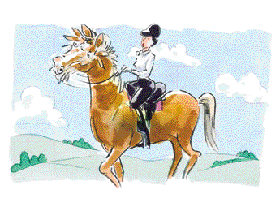|
Although the mechanism is unclear it is considered to be a
nerve problem. A role in regulating the bodyís seasonal
changes is played by melatonin which is a hormone produced
by the body. In certain horses during the spring, summer and
fall there is an unusual decrease in melatonin production
which allows some branches of the trigeminal nerves to be
over stimulated when there is bright sunlight.
 The
irritated nerve may become painful in some cases which results in the
headshaking. This nerve exitís the skull about four inches behind the nostril
which, when irritated, can cause the horse to shake their head and rub their
nose on the ground in order to get relief. Horses may learn that they can avoid
irritation by avoiding sunlight whether this be to standing in the darkest
corner of the stall or burying their head in a pasture mateís tale. The
irritated nerve may become painful in some cases which results in the
headshaking. This nerve exitís the skull about four inches behind the nostril
which, when irritated, can cause the horse to shake their head and rub their
nose on the ground in order to get relief. Horses may learn that they can avoid
irritation by avoiding sunlight whether this be to standing in the darkest
corner of the stall or burying their head in a pasture mateís tale.
This condition seems to be triggered by exercise and almost always aggravates
the condition. Other causes for headshaking should be ruled out first if the
horse shows no clinical signs except during exercise since it could be caused by
tooth problems or resistance to training.
Headshaking may be caused by any type of bits. To decide if this is the solution
for a horse with headshaking that only shows signs during exercise there is a
simple test that you can use.
On a sunny day, lunge the horse in a halter and allow sufficient time for the
nerve to become stimulated. A bitless bridle likely wonít solve the problem if
headshaking occurs. If headshaking is eliminated or greatly reduced by using a
blindfold or lunging after dark then the problem is likely caused by direct
sunlight.
With some success, the drug cyproheptadine has been used to treat photic
headshaking whether used alone or in conjunction with melatonin. Cyproheptadine
affects the transmission of nerve impulses even though it is an antihistamine
and may also help to block excessive stimulation to the branches of the
trigeminal nerve.
You may be able to prevent the onset of sensitivity to bright sunlight that is
associated with spring, summer and fall by supplementing the bodyís natural
melatonin levels to where they equal the levels found in the winter months.
A surgical procedure is available if therapy with cyproheptadine and melatonin
is not successful and can be used to treat persistent cases of photic
headshaking. A definitive diagnosis should be made by a veterinarian before
surgery is performed. A diagnosis can be obtained by blocking the trigeminal
nerve with a local anesthetic.
A trigeminal neurectomy may be effective if there is no evidence of headshaking
while the nerve is blocked. Before the surgery is planned you should have the
block done at least a week in advance to allow the swelling from the block to
subside. After a properly performed surgery, the facial drooping that is present
during the nerve block will not occur again.
The procedure is uncommon so it is good to seek an experienced surgeon even
though the procedure is uncomplicated. About three weeks after surgery the horse
may be put back to work. Even surgery may not offer a permanent solution since
there is the possibility that the nerve will grow back.

|